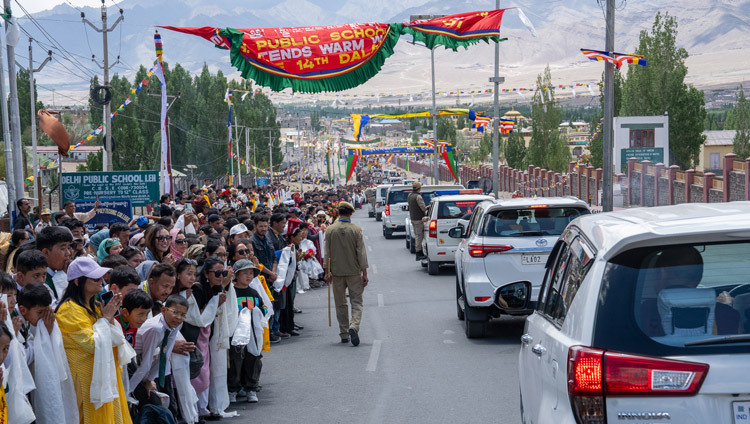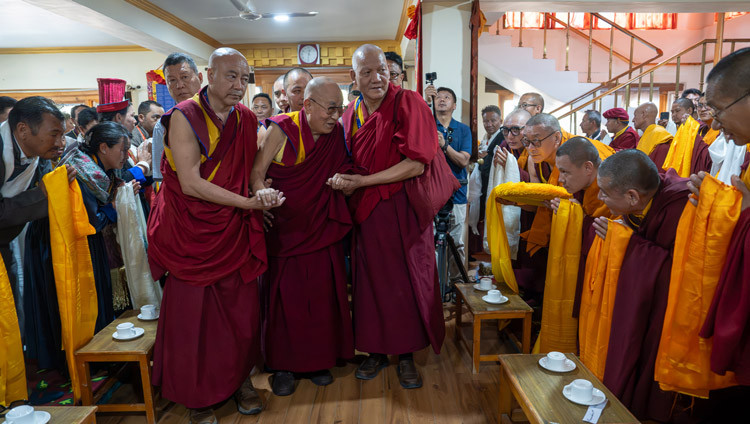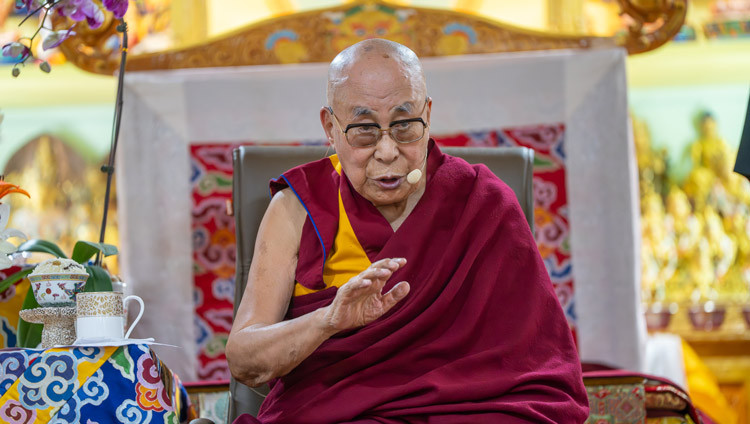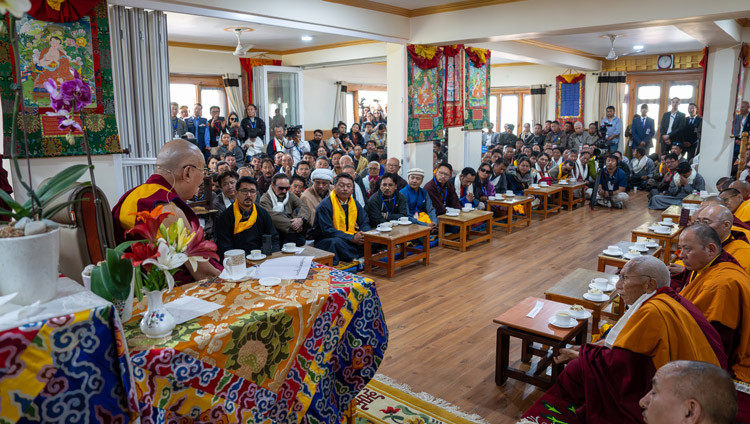Shewatsel, Leh, Ladakh, India - Early today, His Holiness the Dalai Lama flew directly from Dharamsala to Leh, Ladakh. On arrival he was welcomed by Ven Thiksey Rinpoché, Ven Thuksey Rinpoché, the CEC of Ladakh Autonomous Hill Development Council, Tashi Gyalson,the President of the Ladakh Buddhist Association, Dawa Tashi, the President of the Ladakh Gompa Association, Ven Dorjé Stanzin, Representatives of the Muslim and Christian communities, the Director General of Ladakh Police, the Deputy Commissioner (DC) of Leh and the Superintendent of Police.

After a brief welcoming ceremony, His Holiness and his entourage began the nine-kilometre journey to Shewatsel Phodrang. Jubilant people lined the road all the way—Ladakhis, Tibetans and people from elsewhere. Jeeploads of costumed dancers and monk musicians drove in front. In places the crowds were several rows deep. They held flowers, silk scarves and incense in their hands. Others held umbrellas against the fierce sun. Many sang and danced as His Holiness passed. In addition to Buddhists, boys and girls from Muslim schools greeted His Holiness. A surprising number of young people shed tears of joy to see His Holiness as he passed.
At Shewatsel Phodrang His Holiness was greeted by monks and nuns chanting and playing horns, drums and cymbals. At the door to the palace groups of traditional Ladakhi drummers beat out a welcome.
As His Holiness stepped out of the car Thiksey Rinpoché was there to greet him and lead him to the throne inside. The hall was full. Monastics sat to His Holiness’s right while laypeople sat to his left. His Holiness lost no time in addressing the gathering.
“The Buddhism we have in Tibet is something which can be explained scientifically and is practical in terms of meditation practice. So, the Buddhist tradition of Tibet can withstand rigorous testing just as gold is tested by burning, cutting and polishing.
“Scientists don’t make any assertions about past or future lives, nor do they talk about liberation, but they recognize that people who practise Tibetan Buddhism stay calm. Their minds are not disrupted by destructive emotions. If you want to look at Tibetan Buddhism in terms of liberation, there is a long way to go, but if you practise it well, you’ll be calm and engage with others in an affectionate, friendly way.
“I observe Tibetan Buddhism in my own life and have found it very useful. Many of my friends, scientists among them, also recognize the value of our Buddhist traditions.

“People who don’t know what the Dharma really is usually focus on reciting mantras and performing rituals. That’s not the real practice of Dharma. The real practice is to subdue your unruly mind. It’s about transforming your mind so that you’re able to weaken the destructive emotions in order to benefit of all mother sentient beings. Like you they want to be happy and don’t want to suffer. Such beings help us cultivate compassion for others.
“As far as I’m concerned, as soon as I wake up in the morning, I reflect on bodhichitta and emptiness, which really helps me avert attachment and anger, which are untamed states of mind.
“It would be good if you too could all work on those factors that undermine the destructive emotions of attachment and anger by implementing the unique teaching of Buddhism as preserved in our tradition. That is what I try to do.
“I began the memorization and study of philosophical treatises in my childhood. As I grew older and faced all kinds of challenges, I found that what I had learned then included an extremely practical approach to countering the destructive emotions. When I appeared for my Geshé Degree Examination at the various monastic universities around Lhasa and I debated with very skilled Geshés, I realised how effective dialectics and debate are in the study of Buddhism.
“What was crucial for me was not to sit on a high throne as a Tulku, but to debate with the ordinary monks by sitting together with them in the debating courtyard. This is how I shared their spiritual education. Sitting on a high throne, pretending to be a holy Lama is a mistake.
“In my own case, I did not remain idle and aloof. During my examinations I sometimes sat down and answered questions put to me, but also took my turn to pose questions too. I found debate highly effective for my studies. It sharpened my mind and led me to discern reality correctly.

“I had eight Debate Assistants, some of whom were excellent scholars that I found hard to defeat. Unless I had prepared well and thought the topics through before debating with them, it was very difficult to come up with effective questions to dislodge their position in debate. However, the Debate Assistant from Deyang Monastery was one I could outdo and sometimes I fooled him, while at others I bullied him.
“The other Debate Assistants from Losel Ling, Gomang, and Sera represented a challenge in debate and I had to be really well prepared when I debated with them. In fact, Sera and Drepung were well-known for their debate skills, while Ganden monks were fewer in number and were nicknamed ‘Renunciant Hill Retreatants’. The Sera and Drepung scholars were excellent, demonstrating how essential debate is in our study of Buddhist philosophy.
“Of course, in the trans-Himalayan belt you have faith and interest in the Tibetan Buddhist tradition. However, it’s also important for you study the teaching through debate, which is based on the treatise on logic and epistemology, the nature of knowledge, so that you can uproot misconceptions. This is what I did when I was young.
“We have a Tibetan custom of studying both the Middle Way (Madhyamaka) and logic (Pramana) together. This is a unique, useful approach derived from the Nalanda Tradition. I threw myself wholeheartedly into studying both these two.
“I know you people in the trans-Himalayan belt already have well-established educational institutions, but there is always room to improve. I recommend you learn about the Middle Way and logic from your teachers and then exercise what you’ve learned in debate with each other.”
His Holiness alluded to the destruction the Chinese authorities have wrought upon the traditions of studying the great treatises in Tibet. He stressed the importance of scholars from the Himalayan region working to keep these traditions of study alive. He recalled how the chaos in Tibet in 1959 meant he couldn’t stay and had to flee. Since then, he said, the Government of India has been immensely supportive of and has extended tremendous assistance to Tibetans. He reiterated how great learning traditions that could not continue in Tibet have been re-established in centres of learning in India.

“The precious traditions that we can learn and implement in daily life,” he continued, “have declined in Tibet. Those who fled to India have had the responsibility of preserving these traditions. In Tibet many experienced harsh Chinese treatment, so here in the freedom of India we must do whatever we can to preserve these precious traditions.
“In the past we had great practitioners who familiarized themselves with these transformative traditions. This is now very difficult to do in Tibet, which is why it is so important that you people of the trans-Himalayan belt should uphold these traditions.
“I studied hard when I was young and toured the monastic centres of learning to debate with the scholars there during the Great Prayer Festival (Mönlam Chenmo). A lot of Geshés were keen to debate with me, and I am grateful that I was able to debate with them. When I reflect now on what I learned during my debate tour in Lhasa, I feel my life has been meaningful.
“The night I left Norbulingka in 1959 I did a lot of investigation including consulting the Nechung Oracle and doing divinations. I decided to go. We crossed the river running through Lhasa and climbed the pass. From there I looked back at the city where the Chinese authorities had imposed such tight controls that citizens were under great pressure and stress. I felt sad that whereas in the past Lhasa had been a great place to study and learn from the great treatises, it was no more.
“But it’s useless to stay sad. Instead we have to do something. When I reached the Tibetan border with India, I decided I would have to put all my effort into building institutions that would preserve what we used to have. We have done quite well.
“In China, the political situation is not stable, but interest in Buddhism is growing. I have received many messages inviting me to visit China, but I feel it would be difficult to teach about Buddhism in a country where there is no freedom—I feel it’s more effective to teach about Buddhism in India.
“You people of the Himalayan region share a religion and culture with us, especially our language and literature. I have done all I can to revive and strengthen the bonds between us.”
With that His Holiness retired to his quarters for the day.












